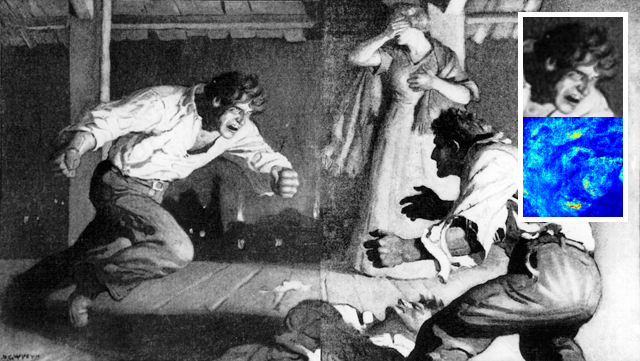X-RAY RUNS: Apply for Beamtime
2017 Nov 1 - Dec 21
2018 Feb 7 - Apr 3
2018 Proposal/BTR deadline: 12/1/17
2018 Apr 11 - Jun 4
2018 Proposal/BTR deadline: 2/1/18

1918 illustration for the story, "Mildest
Mannered Man" by Ben Ames Williams (Everybody's
Magazine) hidden beneath the 1924 N.C. Wyeth painting "Family
Portrait" (Brandywine River Museum). Inset
shows preliminary x-ray data imaging Cadmium (found in
yellow paint) in the face of the villain, Slag
Harshmeyer.
Contact: E. Fontes (ef11@cornell.edu)
Famous or not, many artists put several paintings on a single canvas – sometimes strictly for convenience, but occasionally also to conceal previous work. Curious art historians want to dig out all possible details about paintings and their producers. Historians cannot afford, though, to risk damaging precious works of art.
To aide their efforts a new instrument has been developed at Cornell, called a “confocal X-ray fluorescence (CXRF) microscope,” which lets art historians uncover minute details about buried features without inflicting any damage onto precious works of art. This device focuses an X-ray beam onto a painting and then collects the fluorescent X-rays given off by the chemicals in the various paint layers. Each color of paint will produce a characteristic fluorescence spectrum, a unique “chemical fingerprint”. A special feature of a “confocal” microscope is that it has very fine depth resolution - it can “see” fluorescent light coming from one layer of paint at a time.
The CXRF microscope is the first of its kind at a powerful synchrotron source in the United States, and was built at the Cornell High Energy Synchrotron Source (CHESS) by a team led by staff scientist Arthur Woll. The construction was funded by the National Science Foundation, which also supports the operation of CHESS as a national user facility.
CHESS Director Sol Gruner was quoted in a July 19th article in the Cornell Chronicle: "The key to getting this all to work is to combine the talents of the physicists at CHESS with a powerful group of collaborators, namely, Dr. Mass Jennifer Mass, senior scientist at the Winterthur Museum and Country Estate and a University of Delaware faculty member, Noelle Ocon, associate conservator of paintings at the North Carolina Museum of Art, Christina Bisulca, a graduate of the University of Delaware's program in conservation, and Matt Cushman, a student in the same program. Without these human connections, nothing would happen."
Under investigation was N.C. Wyeth's "Family Portrait" (from the collection of the Brandywine River Museum in Chadds Ford, Pa.). Earlier X-ray images of the entire painting revealed that a second picture was buried. That picture was shown in a 1919 magazine illustration, but the image was only a black-and-white reproduction. Colors and details of the hidden painting were yet to be found.
"N.C. Wyeth wanted to bury his illustrations, so information we can get about how he worked as an illustrator will be of great art-historical significance," quotes the Chronicle from Dr. Mass. "The structure answers a lot of questions: What methods did he use? How did he work?"
The Wyeth painting is the second art project to make use of the new CXRF microscope. Even though it’s only recently commissioned, Woll is looking forward to a number of improvements in scan speed. Currently, scanning a 1 inch square area can take up to ten hours. New hardware control, optics, and faster x-ray fluorescence detectors will speed the process by factors of 10 to 100 in the future. To achieve very high lateral resolution, the team combines CXRF with a faster, less precise type of scanning that does not directly resolve the pigments in each layer. With this mode, the team can scan large portions of the painting in a matter of hours. The slower, but more precise mode is used to resolve ambiguities in the faster scan, such as whether a particular pigment is located in the top or bottom image.
Full article: (pdf)
See the original article in the Cornell Chronicle: http://www.news.cornell.edu/stories/July07/
chessWyethAnalysis.html
See coverage also in the Cornell PawPrint issue July 19th (archived pdf here): http://www.pawprint.cornell.edu/docs/PP_July_19_web_07.pdf
Also on PhysOrg.com: (archived pdf):
http://www.physorg.com/news104161219.html
